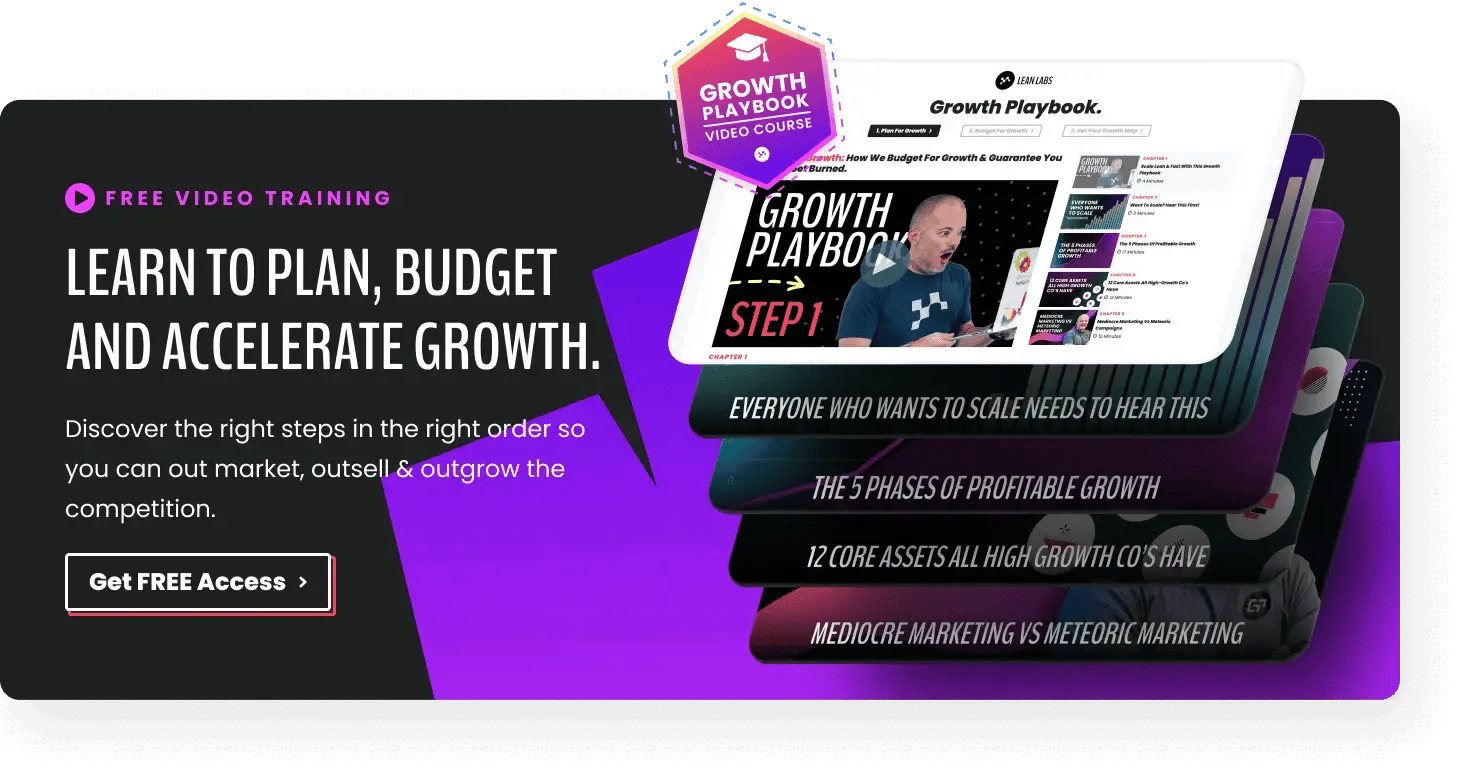Here’s how I think about structure. I went house-hunting a few years ago. While I was looking for the perfect home, I saw a lot of houses that were way off the mark. I saw kitchens located back near the bedrooms, homes with the only bathroom in the basement, and tiny houses split up into a dozen tinier rooms. Before I found the right place, I think I saw it all. The issue that all these bad-fit houses had in common? Structure. These houses were organized in a way that made no sense to me—in a way that wouldn’t work for my family and me.
Your growth marketing team is the same way. If you don’t take the time and care to structure your team in a way that works for your organization, you’re no better off than you would be trying to live in a home with a nonsensical layout.
VIDEO TRAINING
Get The Growth Playbook.
Learn to plan, budget, and accelerate growth with our exclusive video series. You’ll discover:
- The 5 phases of profitable growth
- 12 core assets all high-growth companies have
- Difference between mediocre marketing and meteoric campaigns
Thanks for submitting the form!
We'll review the information you've submitted and respond to you just as soon as possible.
No worries, we can help you avoid these struggles! This post will go over three killer examples of how to structure a growth team that will be ready to crush any goal. Let’s get started.
How To Structure A Growth Team: What Is A Growth Team?
To understand how to structure a growth team, we first need to understand what a growth team is. What your team looks like depends heavily on your growth goals and how growth marketing can help you achieve them.
What is a growth team? Speaking broadly, a growth team is a team that uses data analysis and experimentation in tandem to eliminate friction from your buyer’s journey. Growth teams work in sprints, consistently tackling incremental goals to guide your organization toward achieving ambitious targets.
Related Read: What Is Growth Marketing? 3 Reasons You Can't Afford Not to Know
The secret sauce of growth teams is their cross-functional nature. By enabling your sales, product, and marketing teams to work toward the same goals, you’ll increase alignment and prevent double-work and miscommunications that are common in more siloed work environments.
Your ideal growth team structure depends on several factors, but the largest factor is your business type. We’ll examine three examples in this post: The perfect growth team structure for startups, SMBs, and enterprise businesses.
Regardless of your business type, a growth team should include the following players:
- Head of Growth
- Growth Marketers
- Data Analysts
- Developers
- Designers
Example One: Start-Ups
If your business is a startup, you’re likely working with a small team, trying to achieve more growth with fewer players on the field. For startups, hiring and structuring an entire team in-house is likely not an achievable goal in the short term. Thankfully, there’s another option: Hiring an outsourced or hybrid growth marketing agency.
Working with an outsourced team gives you the ability to achieve your desired results and employ the skills and experience of a full-service team without increasing your payroll costs. However, hiring an outsourced team doesn’t mean you won’t need any players in-house.
When you work with an outsourced or hybrid team, you’ll need two contacts in-house: A decision-maker and an internal marketer. Your decision-maker should be able to approve campaigns proposed by the outsourced team, and your in-house marketer will align the outsourced team with the marketing efforts taking place in-house.
Your internal marketer can hire new marketers based on the practices and processes learned from working with the outsourced team as your business grows.
Example Two: SMBs
If you’re looking to scale a small business, you may be ready to hire a small in-house team to handle your growth marketing efforts. The size of your team will depend heavily on the size of your business. Likely, your team will consist of five to ten players. Regardless of how many team members make up your growth marketing team, you’ll need to fill the following five roles:
- Growth Marketer: This team member will handle creative marketing elements like copywriting and help to establish marketing strategies, campaigns, and more.
- Data Analyst: Data is at the heart of any growth strategy. Your data analyst will keep track of your progress and help you draw actionable insights from those figures.
- Developer: Your developer will work to rapidly implement experiments so your data analyst can compile the results and the rest of the team can iterate and optimize.
- Designer: Your customers will need to see your brand packaged effectively for any growth to take root. Designers will steer that ship for your team, helping you create a brand identity and express that visually.
- Head of Growth: Your growth team needs a leader. Your head of growth works to make sure the team is progressing toward goals, communicating, and working together. This team member is more than just a manager: They’ll need to wade into the thick of the project when the rest of the team needs a boost.
When considering structuring a growth team for your small business, ensure you’re making a concentrated effort to avoid siloing. One easy way to avoid this is to implement frequent team-wide meetings. These meetings provide the entire team with the opportunity to align on key goals and metrics.
As a final note, the CEO of your small business should not be a direct part of your growth team. As the organization's leader, the CEO is a key stakeholder that the growth team will consult with on major decisions, but rather than getting mired in the nitty-gritty of each individual campaign effort, they should receive updates from the Head of Growth.
Example Three: Enterprise
If you’re operating an enterprise company, your growth team structure will be similar to the structures of the earlier examples. Still, as your company and team expand, you have a few more options for your structure. With a larger group, you can tackle multiple goals or campaigns at the same time, and the design of your team will dictate how you divide the work behind those efforts.
When structuring an enterprise growth team, you can choose between two different model types, the Independent Model and the Functional Model.
Independent Model
When you use an independent model for your growth team structure, you split your team up based on the stages of the customer acquisition funnel (Awareness, Acquisition, Revenue, Activation, Retention, Referral). Each team will tackle multiple campaigns but will focus solely on their funnel stage for each campaign.
Contrary to how the name sounds, this model doesn’t mean you’re siloing your efforts, the teams still work together, with all six teams reporting to a VP of Growth, who coordinates the growth efforts of your organization as a whole.
Each of your six funnel-stage-based teams will consist of marketers, designers, data specialists, engineers, developers, and a single project manager.
Functional Model
Similar to the Independent Model, you’ll split your growth team into smaller subsets in the Functional Model. However, instead of dividing your team based on funnel stages, you will create subsets based on specific goals or campaigns.
As a whole, your team will establish tactics and marketing campaigns, then split the entire team up based on those efforts. You can dedicate more or fewer resources and team members to each campaign based on its importance to your growth goals as a whole. Each small team in this model focuses on the full funnel for their specific goal or campaign.
Again, each team will have marketers, designers, data specialists, engineers, developers, and a single project manager, and one VP-level executive will coordinate and align the efforts of all the smaller teams.
Answered: How To Structure A Growth Team For Maximum ROI
By examining your business size and growth goals, you should determine which of the above examples of how to structure a growth team will work best for your organization. The key to successfully using any of these structures is to embrace experimentation, data analysis, and cross-functionality between teams.
Regardless of which structure you choose, you’ll need to employ key tenets of growth marketing for your efforts to deliver maximum ROI. Combined, the team at Lean Labs has decades of experience helping deserving brands achieve incredible growth. To learn our secrets, check out our Growth Marketing Strategy Kit today.








